Aftermath
When the story was published in the 1961 edition of Szilard's collection, The Voice of the Dolphins, and Other Stories , the book stated that the story was required reading for students at Harvard Law School.
According to William Lanouette speaking at the 2005 World Science Forum in Budapest, a Russian language translation of Szilard's story played a key role in Soviet physicist Andrei Sakharov's objections to the Soviet nuclear weapons program. [4] [5] [6]
External links
- My Trial as a War Criminal Manuscript and original publication.
Related Research Articles

Edward Teller was a Hungarian-American theoretical physicist who is known colloquially as "the father of the hydrogen bomb" and one of the creators of the Teller–Ulam design. Teller was known for his scientific ability and his difficult interpersonal relations and volatile personality.
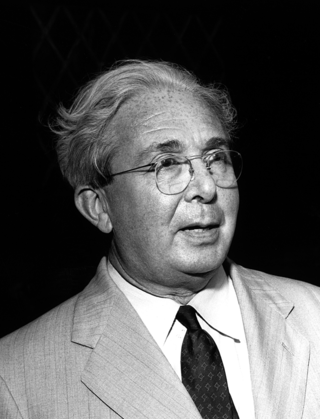
Leo Szilard was a Hungarian-German-American physicist and inventor. He conceived the nuclear chain reaction in 1933, patented the idea in 1936, and in late 1939 wrote the letter for Albert Einstein's signature that resulted in the Manhattan Project that built the atomic bomb. According to György Marx, he was one of the Hungarian scientists known as The Martians.
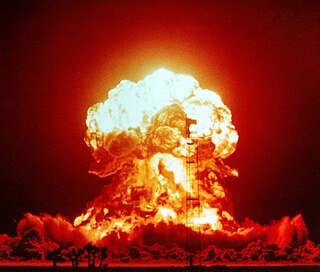
Building on major scientific breakthroughs made during the 1930s, the United Kingdom began the world's first nuclear weapons research project, codenamed Tube Alloys, in 1941, during World War II. The United States, in collaboration with the United Kingdom, initiated the Manhattan Project the following year to build a weapon using nuclear fission. The project also involved Canada. In August 1945, the atomic bombings of Hiroshima and Nagasaki were conducted by the United States, with British consent, against Japan at the close of that war, standing to date as the only use of nuclear weapons in hostilities.

Yulii Borisovich Khariton was a Russian physicist who was a leading scientist in the former Soviet Union's program of nuclear weapons.

Chicago Pile-1 (CP-1) was the world's first artificial nuclear reactor. On 2 December 1942, the first human-made self-sustaining nuclear chain reaction was initiated in CP-1 during an experiment led by Enrico Fermi. The secret development of the reactor was the first major technical achievement for the Manhattan Project, the Allied effort to create nuclear weapons during World War II. Developed by the Metallurgical Laboratory at the University of Chicago, CP-1 was built under the west viewing stands of the original Stagg Field. Although the project's civilian and military leaders had misgivings about the possibility of a disastrous runaway reaction, they trusted Fermi's safety calculations and decided they could carry out the experiment in a densely populated area. Fermi described the reactor as "a crude pile of black bricks and wooden timbers".

The Soviet atomic bomb project was the classified research and development program that was authorized by Joseph Stalin in the Soviet Union to develop nuclear weapons during and after World War II.
RDS-37 was the Soviet Union's first two-stage hydrogen bomb, first tested on 22 November 1955. The weapon had a nominal yield of approximately 3 megatons. It was scaled down to 1.6 megatons for the live test.
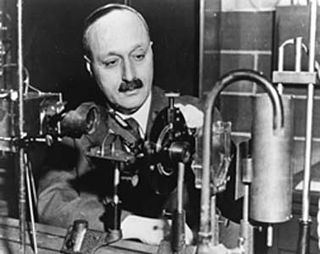
The Franck Report of June 1945 was a document signed by several prominent nuclear physicists recommending that the United States not use the atomic bomb as a weapon to prompt the surrender of Japan in World War II.
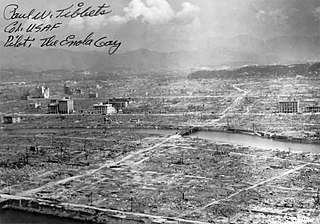
The nuclear weapons debate refers to the controversies surrounding the threat, use and stockpiling of nuclear weapons. Even before the first nuclear weapons had been developed, scientists involved with the Manhattan Project were divided over the use of the weapon. The only time nuclear weapons have been used in warfare was during the final stages of World War II when USAAF B-29 Superfortress bombers dropped atomic bombs on the Japanese cities of Hiroshima and Nagasaki in early August 1945. The role of the bombings in Japan's surrender and the U.S.'s ethical justification for them have been the subject of scholarly and popular debate for decades.
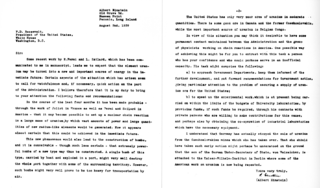
The Einstein–Szilard letter was a letter written by Leo Szilard and signed by Albert Einstein on August 2, 1939, that was sent to President of the United States Franklin D. Roosevelt. Written by Szilard in consultation with fellow Hungarian physicists Edward Teller and Eugene Wigner, the letter warned that Germany might develop atomic bombs and suggested that the United States should start its own nuclear program. It prompted action by Roosevelt, which eventually resulted in the Manhattan Project, the development of the first atomic bombs, and the use of these bombs on the cities of Hiroshima and Nagasaki.

Atomic spies or atom spies were people in the United States, the United Kingdom, and Canada who are known to have illicitly given information about nuclear weapons production or design to the Soviet Union during World War II and the early Cold War. Exactly what was given, and whether everyone on the list gave it, are still matters of some scholarly dispute. In some cases, some of the arrested suspects or government witnesses had given strong testimonies or confessions which they recanted later or said were fabricated. Their work constitutes the most publicly well-known and well-documented case of nuclear espionage in the history of nuclear weapons. At the same time, numerous nuclear scientists wanted to share the information with the world scientific community, but this proposal was firmly quashed by the United States government. It is worth noting that many scientists who worked on the Manhattan Project were deeply conflicted about the ethical implications of their work, and some were actively opposed to the use of nuclear weapons.

The Szilárd petition, drafted and circulated in July 1945 by scientist Leo Szilard, was signed by 70 scientists working on the Manhattan Project in Oak Ridge, Tennessee, and the Metallurgical Laboratory in Chicago, Illinois. It asked President Harry S. Truman to inform Japan of the terms of surrender demanded by the allies, and allow Japan to either accept or refuse these terms, before America used atomic weapons. However, the petition never made it through the chain of command to President Truman. It was not declassified and made public until 1961.

Hiroshima is a 1995 Japanese-Canadian war drama film directed by Koreyoshi Kurahara and Roger Spottiswoode about the decision-making processes that led to the dropping of the atomic bombs by the United States on the Japanese cities of Hiroshima and Nagasaki toward the end of World War II. The three-hour film was made for television and had no theatrical release.
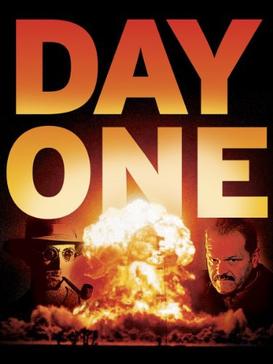
Day One is a made-for-TV docudrama film about The Manhattan Project, the research and development of the atomic bomb during World War II. It is based on the book by Peter Wyden. The film was written by David W. Rintels and directed by Joseph Sargent. It starred Brian Dennehy as General Leslie Groves, David Strathairn as Dr. J. Robert Oppenheimer and Michael Tucker as Dr. Leo Szilard. It premiered in the United States on March 5, 1989 on the CBS network. It won the 1989 Emmy award for Outstanding Drama/Comedy Special. The movie received critical acclaim for its historical accuracy despite being a drama.

Substantial debate exists over the ethical, legal, and military aspects of the atomic bombings of Hiroshima and Nagasaki on 6 August and 9 August 1945 at the close of World War II (1939–45).
A salted bomb is a nuclear weapon designed to function as a radiological weapon by producing larger quantities of radioactive fallout than unsalted nuclear arms. This fallout can render a large area uninhabitable. The term is derived both from the means of their manufacture, which involves the incorporation of additional elements to a standard atomic weapon, and from the expression "to salt the earth", meaning to render an area uninhabitable for generations. The idea originated with Hungarian-American physicist Leo Szilard, in February 1950. His intent was not to propose that such a weapon be built, but to show that nuclear weapon technology would soon reach the point where it could end human life on Earth.
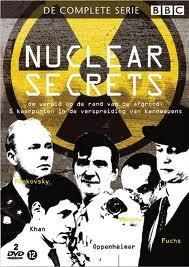
Nuclear Secrets, aka Spies, Lies and the Superbomb, is a 2007 BBC Television docudrama series which looks at the race for nuclear supremacy from the Manhattan Project through to Pakistan's nuclear weapons programme.
Oleg Alexandrovich Lavrentiev was a Ukrainian physicist in the former Soviet program of nuclear weapons whose research contributions were fundamental to understanding of thermonuclear fusion.
Viktor Borisovich Adamskyk.N was a Russian physicist of Ukrainian origin known for his work on the former Soviet program of nuclear weapons.
Genius in the Shadows is a 1992 biography of Leo Szilard by William Lanouette. Leo Szilard was a Hungarian-German-American physicist who is most well known for discovering the nuclear chain reaction. The book covers Szilard's personal life and his work.
References
- ↑ Szilard, Leo (1949). "My Trial As a War Criminal". The University of Chicago Law Review. 17 (1): 79-86 . Retrieved 27 September 2023.
- ↑ Szilard, Leo (1961), "My Trial as a War Criminal", The Voice of the Dolphins , New York: Simon & Schuster, pp. 75-86, ISBN 978-0-8047-1754-0 – via Internet Archive
- ↑ Howard Gest. "The July 1945 Szilard Petition, on the Atomic Bomb, Memoir by a signer in Oak Ridge" (PDF). Archived from the original (PDF) on 2009-03-27.
- ↑ William Lanouette (2005-11-10). "Szilardian Science and Politics: Evolution, Revolution, or Subversion?". World Science Forum, Budapest. Archived from the original on 2011-07-21.
- ↑ William Lanouette (2009-03-14). "Scientists and Politicians: The Art of the Impossible". Atomic Heritage Foundation. Archived from the original on 2011-06-12.
- ↑ Charles Rhéaume (2008). "Western Scientists' Reactions to Andrei Sakharov's Human Rights Struggle in the Soviet Union, 1968–1989". Vol. 30, no. 1. Human Rights Quarterly. pp. 1–20. Archived from the original on 2015-09-05.